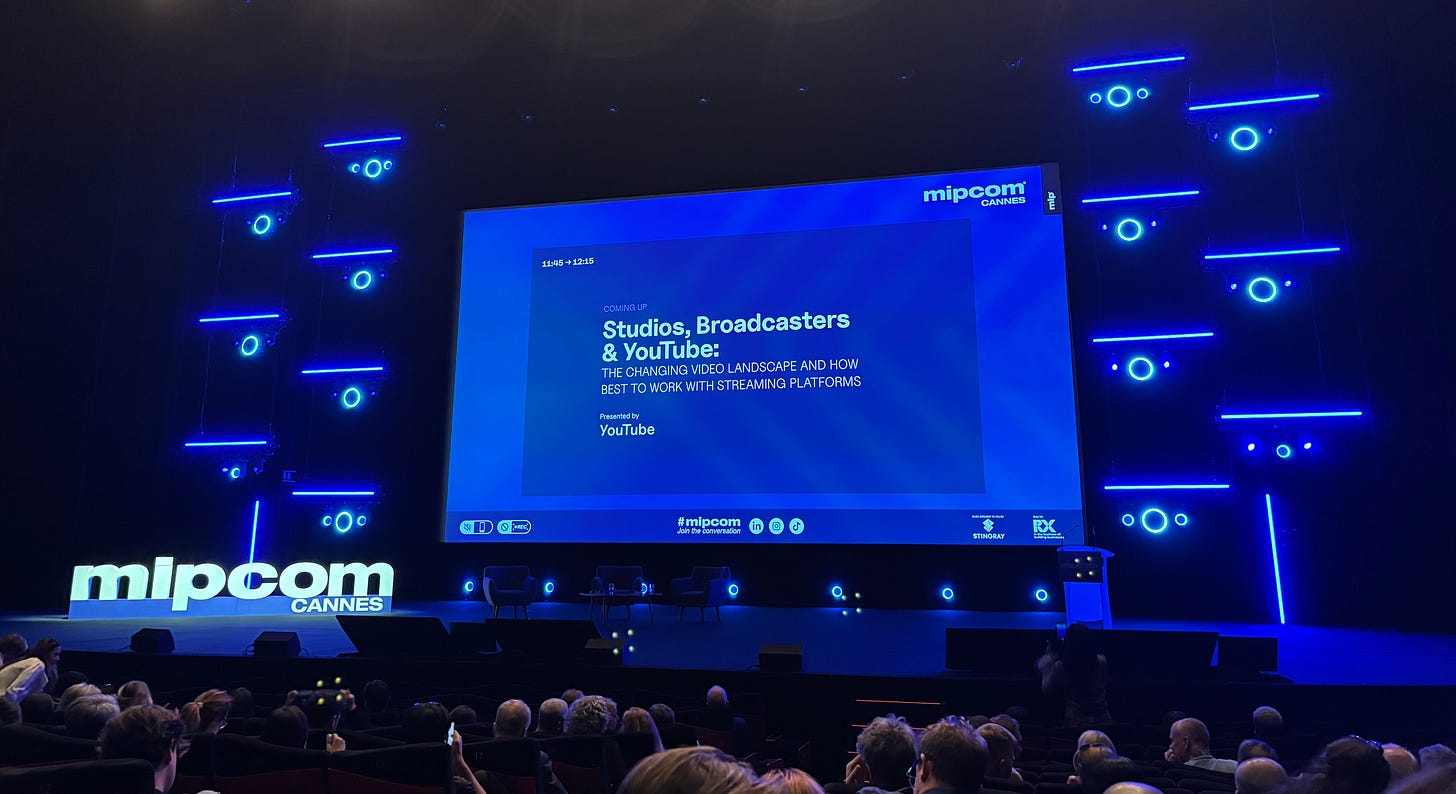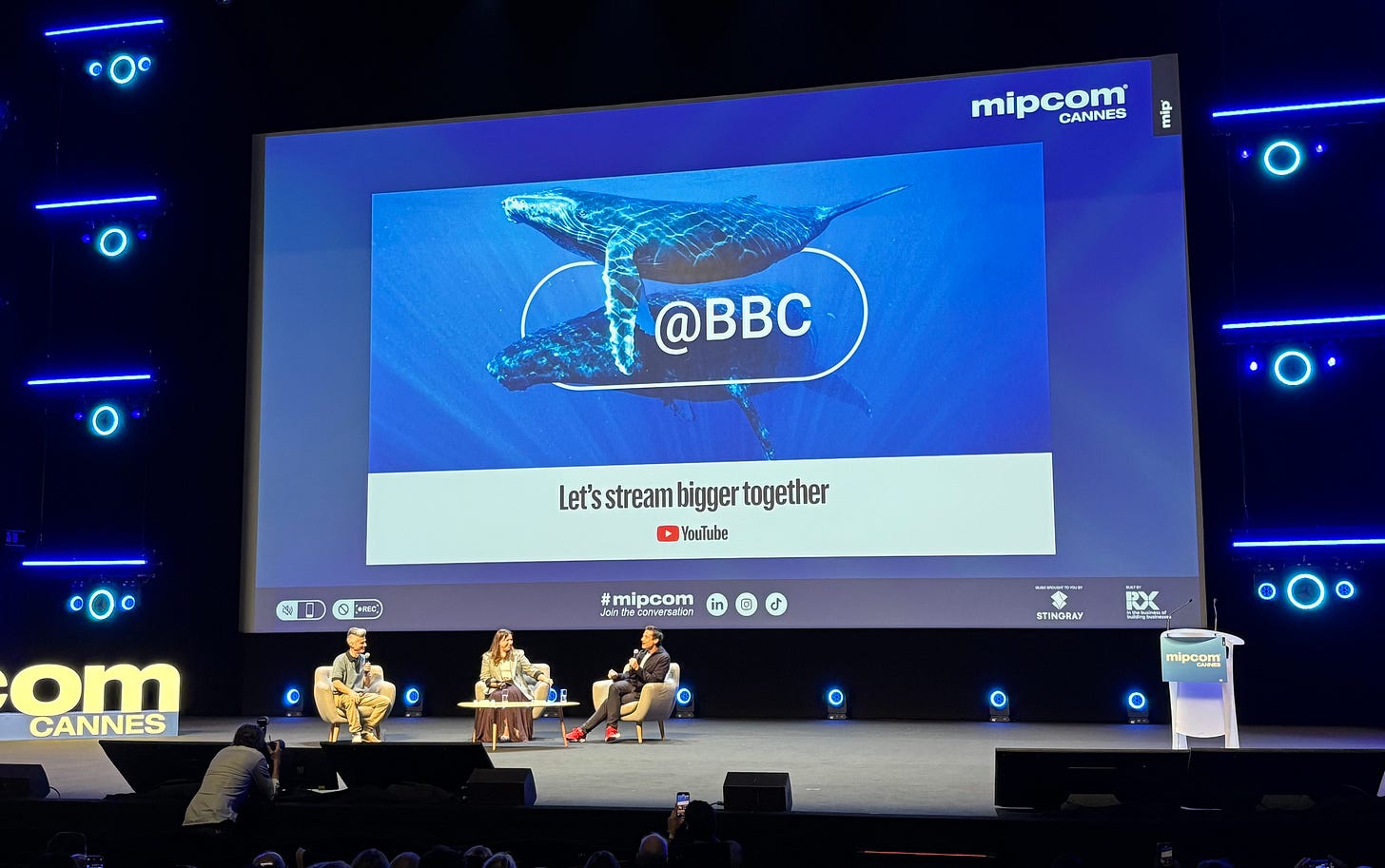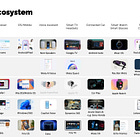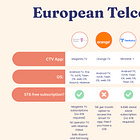How YouTube plans to win "old" TV’s heart
Inside YouTube’s campaign to turn broadcasters into believers.
Streaming Made Easy is funded by direct subscriptions from readers like you. If you’d like the full experience, consider becoming a Premium member 🫶
At MIPCOM 2025, YouTube is not a guest, it’s a host and one you can’t miss, no matter how much you want to try. YouTube is coming with a branded space, keynotes, workshops and a full program track on formats and monetisation. YouTube wants to fit in.
Despite what many might think, it’s a good thing to have YouTube in town. 2025 marks the 41th edition of MIPCOM (I’ve done 15 of these …) and we needed new blood at the conference because along with YouTube came the Creator Economy ecosystem (creators, agencies, tech enablers etc.).
That French saying “it’s in old pots that you make the best soup” doesn’t fly anymore for Media & Entertainment. We’ve always needed to reinvent ourselves and this year is it just like when Netflix came into the market. For years, Netflix was the enemy because they were agents of change. Right now, YouTube is that agent and despite all the debates and resistance, the day will come where most M&E companies will have developed a YouTube business and then they’ll need a new agent of change to treat as the enemy. This is human nature, we change only when we have to.
If you follow my work, you’ll remember the UK article I wrote last spring on how BBC, Channel 4, ITV and Channel 5 wrestled with YouTube (format experimentation, visibility battles, ad splits). Next week, I’m launching a series on French broadcasters on YouTube to see how France Télévisions, TF1, M6 and Arte are navigating this shift (successes, failures, blind spots).
Consider today’s article the prologue with Andreas Briese, MD YouTube for the DACH region, who spoke during Streaming Made Easy Live last month. It’s your ticket to the YouTube pitch to broadcasters in Europe and beyond.
At a glance:
The genesis
The big-screen surprise
The multi-revenue play
Protect, learn and play
Starting from zero
🎥 Watch Andreas’ keynote during Streaming Made Easy Live.
📑 Bonus for Premium subscribers: 📑 Grab our premium edition to download Andreas’s deck.
The genesis
Briese opened with nostalgia: the first YouTube upload (a 19-second zoo clip) and a punchline. That was 20 years ago.
Fast forward to 2025, YouTube has paid $70 billion to creators and media companies and turned into what he called “the home of all formats”:
Shorts spark discovery.
Long form builds loyalty.
Live turns loyalty into events.
Podcasts deepen fandom.
The lesson? A single show can now live as a 15-second teaser, a 45-minute episode, and a 2-hour livestream without leaving the same ecosystem.
The big screen surprise
Even YouTube didn’t expect this one: the living room is now its biggest screen. In the US, YouTube is the #1 streaming app on connected TVs. Half of that watch-time comes from videos over 20 minutes. Briese’s takeaway was blunt: viewers didn’t abandon long-form content, they just changed platforms.
The multi-revenue play
Advertising is still YouTube’s backbone, but it’s no longer the whole body:
55 % ad-revenue share with partners
125 million Premium subscribers
Fan memberships, shopping, PPV, sponsorships
Partner Sales Program letting broadcasters sell their own inventory
“YouTube is only successful when you are successful”, Briese said. It’s a rare sentence to hear from a tech platform and one designed to win over old-school media. Pedro Pina was on stage yesterday and said it too, twice.
Protect, learn and play
Behind the scenes, YouTube is expanding its creator infrastructure:
Content ID now protects video, audio, and soon faces and voices.
Analytics give minute-by-minute performance data richer than any TV panel.
Multi-language audio turns local hits into global exports (40 % of dubbed watch-time comes from alternate languages).
And Briese urged one final thing: experiment. Watch-alongs, trailer reactions, extended cuts, formats TV never had room for. YouTube is a laboratory.
Starting from zero
Is that even possible in 2025? 100% according to Briese. His advice to broadcasters was disarmingly simple: “You have the content. We have the technology. Build your home.”
Start with one of three models:
Network channels (the umbrella brand)
Show/IP channels (flagship formats like The Voice)
Genre channels (comedy, kids, lifestyle)
Then post, learn, iterate. Every creator did. Broadcasters can too. Frequency and consistency, not perfection, drive growth.
🎥 Watch Andreas’ keynote during Streaming Made Easy Live:
📑 Download the full presentation here.
That’s it for today but before you go: comments, likes or shares come a long way 🙏🏻
Enjoy your week and see you on Thursday for another edition of Streaming Made Easy!









